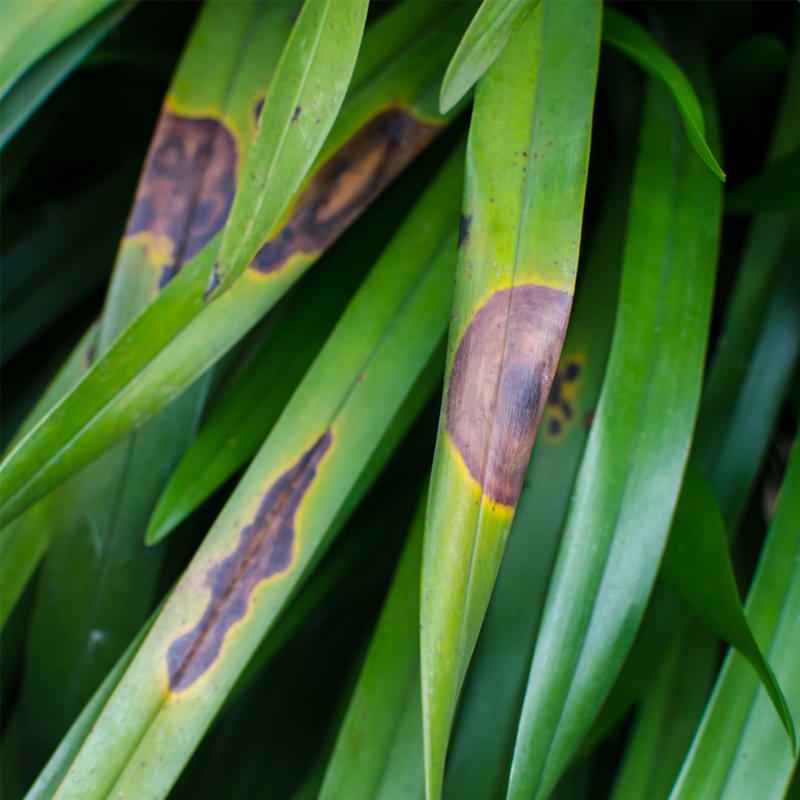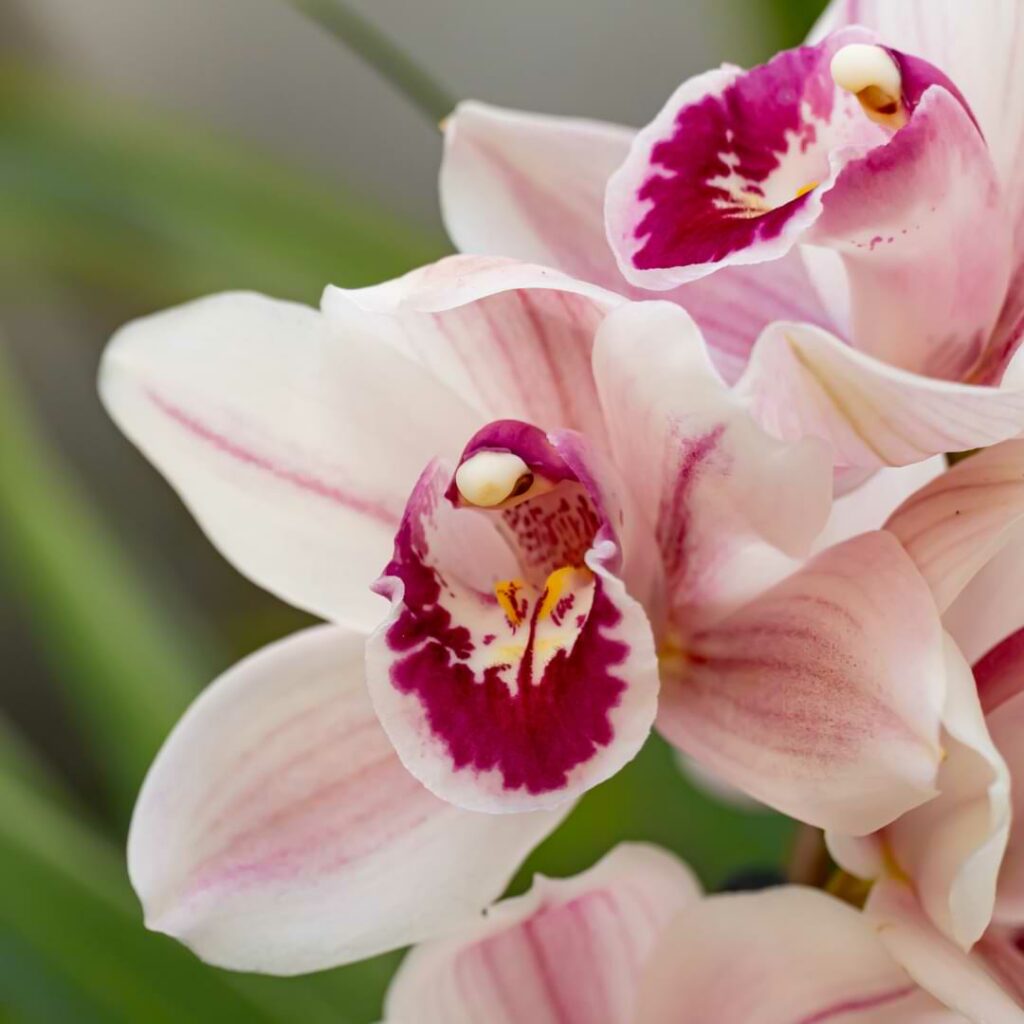Orchids are gorgeous tropical flowers that come in a variety of shapes, sizes, and colors. They are one of the most popular houseplants because they require minimal maintenance and add an extra touch of beauty to any home. But like with any other plant, orchids can suffer from various issues over time.
One such issue is browning leaves, which can be caused by various factors such as too much sun or insufficient watering. Let’s explore thirteen reasons why your orchid leaves may turn brown and what you can do about it. From fungal infections to nutrient deficiencies and more – read on to find out all the possible culprits behind your orchid’s browning leaves!
Common Symptoms Of Orchid Leaves Turning Brown
Orchid leaves turning brown is a common problem that can be caused by a number of different factors. Here are the symptoms to look out for.
Orchid Leaf Turning Brown
This one may be a bit obvious, but it’s critical. If you have one or two leaves on your orchid plant that are turning brown, there is something going on with your plant that needs to be taken care of before it takes your whole plant.
Brown And Yellow Leaves
An orchid with brown and yellow leaves is suffering from different issues than an orchid with only brown leaves. This symptom could be caused by a few different problems, including over- or under-watering, pests, disease, and more.
Brown and yellow leaves on an orchid will typically look like either the very end of the leaf turning yellow, or the whole leaf quickly turning a yellow-orange color. There can be brown on the edge, with a yellow transition to the part of the leaf that is still green, or it can be splotches or yellow and brown throughout the leaf.
Orchid Leaves With Brown Tips
Brown tips on your orchid leaves are a different problem than fully-brown leaves. As you’ll see below, this symptom likely has a different cause than when a whole leaf turns brown.
Depending on the severity of the brown tip and how long the problem has gone untreated, it could only be the very edge, where the leaf turns to a point, or it could go further down the leaf.


Brown Spots
Brown spots are one of the most common forms of brown leaves on orchids, and they can be caused by a number of problems as well, including pests, disease, too much sun, and more. Brown spots on orchid leaves can range from tiny pin-prick size spots to larger spots, sometimes as large as a dime! They might have a small yellow ring around the spot, or a brown spot with black in the middle, but they can also just be brown with no other coloring.
Causes of Brown Leaves On Orchids & How to Fix
(For each numbered ‘cause’ include a description of how the problem can arise, how the leaves will be affected and how to fix the issue)
Put on your detective hat, because it’s time to investigate the cause of your orchid’s leaves turning brown. Get your plant close by, and go through these thirteen reasons to see if you can successfully diagnose your orchid, so you can fix the problem and nurse your plant back to health.
As you read through these possible causes, please keep in mind that when you fix the problem that is causing your orchid’s leaves to turn brown, it will not “heal” the existing brown spots or brown leaves. You may need to remove the affected leaves once the problem is resolved so your plant can put its energy into producing new, healthy leaves.
1) Overwatering
More water is not always better. In fact, overwatering is one of the most common reasons orchids die, and one of the first indicators that your plant is getting too much water is – you guessed it, brown leaves.
What is happening: When an orchid is overwatered, the roots are unable to get the oxygen they need and will start to rot. This can cause the leaves to turn brown and eventually die. If the problem is not resolved quickly, it could kill the whole plant. Root rot kills plants quickly.
Where to check: If you think your orchid may be overwatered, check the roots to see if they are soft or mushy. You’ll need to unpot the whole plant, and loosen the soil around the roots. If root rot is the culprit, it will be very obvious once you remove the plant from the pot. The soil will be soggy and the roots will be brown and soft instead of light and healthy.
How to fix it: If your orchid’s roots are rotted, you will need to repot your plant as soon as possible. Remove all of the existing soil, rinsing it off if needed. Thoroughly inspect the roots and remove any rotted roots using sharp, clean pruning shears. Once you’ve removed all dead roots, repot your orchid in fresh orchid potting mix.
Yes, it’s tempting to use the same soil you had your plant in before, but please don’t do this. Replacing the soil is important for your plant’s health to prevent any possible bacteria that has formed in the soil from further harming your plant’s roots.
2) Underwatering
Another common reason that orchid leaves turn brown is underwatering.
What is happening: When orchids don’t get enough water, their leaves will start to turn brown and wilt. This is a clear sign that your orchid is thirsty and needs more water. At first, there may not be much change in your plant, but as time goes on without enough water, your plant will lack the energy, nutrients, and oxygen it needs to thrive.
Where to check: Feel the leaves of your orchid. Are the brown leaves crunchy and dry? Next, look at the soil. If the soil is dried out, your brown leaves are definitely because of underwatering.
How to fix it: Make sure to water your orchid regularly, especially during the warmer months when they need it the most. Use a moisture meter to ensure you are watering your orchid adequately, and you may even want to set a reminder on your phone for every 5-7 days to check on your orchid’s water level. You may need to water more frequently while your orchid recovers.
3) Water Quality
Water quality is often the reason orchid leaves turn brown if your city water or well water is over-populated with chemicals or additives.
What is happening: Chlorine and other chemicals in tap water can damage orchid leaves, causing them to turn brown.
Where to check: This one is rather hard to check for, and can take some serious investigating. You can always have your water tested, but a simpler and cheaper way to check if this is the problem behind your orchid’s brown leaves is by using distilled water for your plant for a month or two, and see if it resolves the issue.
How to fix it: If you’ve tested the theory, and found that brown spots stop appearing, consider using only distilled or purified water for your plant from now on. You can also let tap water sit out overnight before using it on your orchids to allow the chlorine to evaporate.
4) Soil Conditions
The soil you use can have a big impact on the health of your plant. If your orchid’s leaves are turning brown, it could be a sign that the soil is not providing enough nutrients or drainage.
What is happening: If your soil is old, holds either too much or too little water, or has no nutrients left for your orchid, it’s basically starving your plant. That can cause the leaves to turn brown, and if not resolved, could potentially kill your plant.
Where to check: Check the soil! Take a good look at it, dig through it if need be. See if it’s holding a good amount of moisture when you water it. If you notice your soil dries out completely a day after you’ve watered your plant, or if it doesn’t dry out for weeks, your soil is likely the culprit behind your orchid’s brown leaves.
How to fix it: There are a few things you can do to improve the soil conditions for your orchid. You can add some organic matter to the potting mix, such as bark chips or sphagnum moss. This will help provide nutrients and improve drainage. You can also replace the soil completely, and repot your orchid with a potting mix specifically designed for orchids and other tropical plants.
5) Excessive Sun Exposure
Orchids are tropical plants that thrive in humid, shady environments. They can tolerate some direct sunlight, but too much sun will damage their leaves.
What is happening: Since orchids are not too fond of direct sunlight, their leaves will get scorched from getting too much of it. This will look like a sunburn would look on you or me, but instead of red, it will turn the leaf brown. If sunlight is concentrated on one spot, like it would be through a glare, it may even burn a hole in the leaf.
Where to check: Check your orchid’s leaves, inspect the brown parts. If the whole plant gets too much sun, the whole leaf will likely be brown. If it’s only getting strips of sun (like it would through window coverings), it may mimic the pattern where the sun hits the leaves the most.
How to fix it: If you notice that your orchid’s leaves are turning brown, try moving it to a shadier spot, or provide some sort of barrier between your orchid and the sun’s rays. Many people choose to use sheer window curtains to protect their plants from the strongest rays while still allowing some natural light to come through.
6) Lack of Humidity
Lack of humidity is another very common reason orchid leaves could turn brown.
What is happening: The ideal humidity for most orchids is between 40-60%, and when an orchid’s environment is under the suggested humidity levels for a long time, it can cause browning of the leaves.
Where to check: Check your home’s humidity levels. If your home air is particularly dry, it’s easy to guess that your orchid doesn’t have enough humidity. You can also check this metric by using a humidity meter.
How to fix it: Place your orchid on a humidity tray filled with water, or place a humidifier close to your plant.
7) Cold Damage
As mentioned before, orchids are tropical plants, and they don’t like the cold.
What is happening: If your orchid is exposed to temperatures below 50 degrees Fahrenheit, its leaves may turn brown. When exposed to cold temperatures, the orchid can not properly sustain itself. Cold damage can also happen if your orchid is near a window (or touching a window) during the colder months.
Where to check: Check the orchid’s environment. If your home is kept on the colder side, that could be the reason your orchid’s leaves are turning brown. If your orchid is placed near a cold or drafty door or window, that could also be the reason.
How to fix it: If this is the reason behind your orchid’s brown leaves, you will have to move your orchid to a warmer location. You may also be able to place a space heater near your plant (not too close, of course!) to give it that extra warmth it needs. Just be careful of lowering humidity levels if you choose to use a space heater.
8) Over-fertilizing
Sometimes, less is more. Orchids do love their fertilizers, but over doing it could be detrimental.
What is happening: Fertilizer burn happens when you’ve given your plant too much fertilizer than it can handle. It burns the roots and will eventually kill the plant if not taken care of. Typically, the first sign of over-fertilizing is the browning of the leaves.
Where to check: You typically can’t see fertilizer burn. You have to use deductive reasoning to figure this one out. If you’ve recently fertilized your plant, and all of a sudden see that the leaves are turning brown and the plant is looking sickly, it is likely due to over-fertilizing.
How to fix it: Flush your soil immediately. Place the pot in the sink or shower and flush water through the soil for at least 10 minutes. This will hopefully strip away any extra fertilizer that has not yet been absorbed by your plant.
This problem will take several weeks to recover from, but your plant should be fine if you caught the problem in time. Do not fertilize your orchid for at least 2 months after it has recovered from fertilizer burn, and when it is time to start fertilizing again, start at a quarter strength, then increase the strength slowly each time you feed it.
9) Diseases
It’s tough to diagnose a disease as the problem behind your orchid’s brown leaves, but it is a semi-common issue.
What is happening: Your plant could potentially be getting attacked by a fungus or bacteria, causing the leaves to turn brown. Depending on the disease, the brown on the leaf could be spots, edges, or the entire leaf.
Where to check: This problem is fairly hard to check for. Typically, the best course of action is to use a disease diagnosing guide if you want to figure out the exact disease that is affecting your plant.
How to fix it: The best way to get rid of the disease that is causing your orchid’s leaves to turn brown is by treating your plant with a fungicide or with a science-backed home remedy.
10) Pests
Show me a houseplant owner, and I’ll show you someone who hates houseplant pests. They are one of the most common reasons plants get sick.
What is happening: Either your soil has too much moisture, or a pest has simply found its way to your plant and decided to make itself at home. Pests range from fungus gnats that thrive in moist soil to spider mites that live on leaves, and even pests that can’t usually be seen unless under a microscope.
Where to check: Check the top of bottom of every leaf on your plant, and check the soil. If you see little creepy-crawlies, they are likely the cause of your orchid’s brown leaves.
How to fix it: Insecticidal soap or neem oil are usually the most effective treatments to rid your plant of pests. There are many other natural remedies to get rid of pests, but these two options typically work for most types of infestations.
11) Needs Repotting
Although not always the first thing you think about when your orchid’s leaves turn brown, a pot that is too small will cause stress to your plant.
What is happening: Over time, the roots of an orchid can become crowded, which can lead to stress on the plant. When this happens, you may see the tips of the leaves turn brown.
Where to check: Look at the bottom of your plant’s pot. If you see roots trying to grow out of the drainage holes, it’s time for a bigger pot. If you don’t see roots trying to come out, gently remove it from its current pot and check the roots. If they are tightly packed together or if you see any sign of rotting, it’s time for a new pot.
How to fix it: Choose a pot that is slightly larger than the current one and fill it with fresh orchid potting mix. Then simply repot your orchid, place it back in its original spot, and water it like normal.
12) Transplant Shock
One of the most common reasons orchid leaves turn brown is because of transplant shock.
What is happening: This can happen when the plant is moved from one pot to another, or when it’s first repotted. The plant is stressed from the change in environment and needs time to adjust. The leaves will usually start to turn brown at the tips and work their way down. If the plant is severely affected, the leaves may turn brown all over and eventually fall off.
Where to check: This is another problem that doesn’t have a set way to determine that this is the cause. If you’ve recently repotted it, or moved it across town to a new home, and the leaves begin to turn brown shortly after, it’s likely because of transplant shock.
How to fix it: If you think your orchid has transplant shock, the best thing to do is leave it alone and give it time to recover. Don’t fertilize or water it until the leaves start to green up again. Once they do, slowly increase the amount of water and fertilizer you give it until it’s back to its normal routine.
13) Spent Leaves
This is potentially one of the more frustrating reasons an orchid’s leaves will turn brown.
What is happening: Sometimes, a leaf is just too old. When a leaf has given the plant all it can, it will begin to turn brown and will eventually fall off.
Where to check: If there is no other reason for your orchid’s leaves to turn brown, it may just be time for that leaf to die to make room for new leaves to grow in.
How to fix it: There is no fix for this problem, and it’s a completely normal process in a plant’s life.
Removing Brown Leaves On Orchids
You want to be careful when removing brown leaves from your orchid. If the brown leaves are not diseased and are not causing any other health problems, there’s no need to remove them other than for aesthetics. If you do wish to remove the brown leaves, make sure your orchid has at least two healthy leaves that you plan on keeping, to allow the plant to still take in light.
Orchid Leaves Turning Brown FAQ
What are the signs of an orchid dying?
The most common sign that an orchid is dying is when the leaves start to turn brown. Other signs that an orchid is dying include yellowing leaves, wilting flowers, and soft stems. If you notice any of these signs, check for the cause and take steps to fix it. Dying orchids can sometimes be revived, so try to take the steps necessary to save your plant.
Leaves On Orchid Turning Brown Final Thoughts
Though there can be many reasons why orchid leaves turn brown, in most cases, it is due to improper care. Over- or under- watering, too much or too little light, and incorrect potting soil are the most common mistakes made when caring for an orchid. With a little research and practice, you can easily avoid these problems and keep your orchid healthy and beautiful for years to come.
To learn more about orchids, check out our other articles or visit our online shop. We also invite you to join our Facebook community where you’ll find everything you need to know to grow your orchid garden and connect with other orchid lovers just like you.






